Fast-Moving Consumer Goods (FMCG) Packaging Market Size
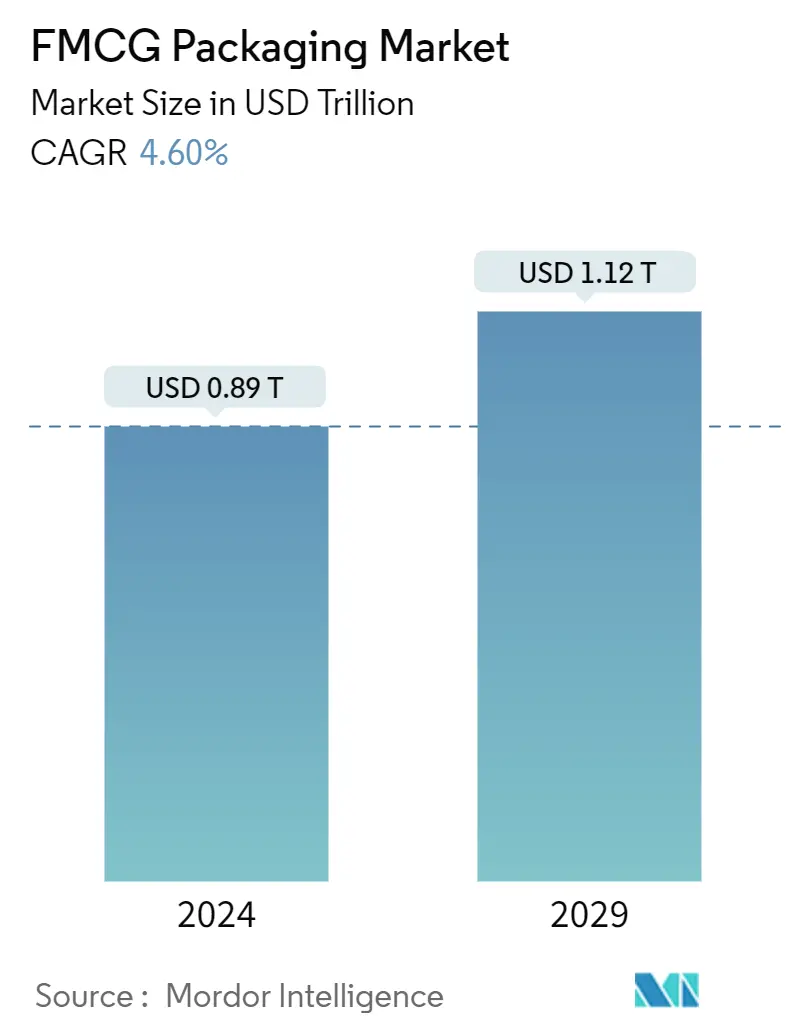
| Study Period | 2019 - 2029 |
| Market Size (2024) | USD 0.89 Trillion |
| Market Size (2029) | USD 1.12 Trillion |
| CAGR (2024 - 2029) | 4.60 % |
| Fastest Growing Market | Asia Pacific |
| Largest Market | North America |
Major Players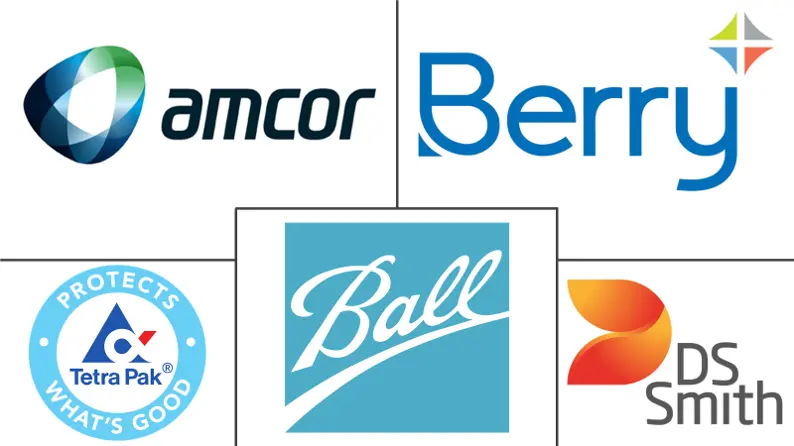
*Disclaimer: Major Players sorted in no particular order |
Need a report that reflects how COVID-19 has impacted this market and its growth?
Fast-Moving Consumer Goods (FMCG) Packaging Market Analysis
The FMCG Packaging Market size is estimated at USD 0.89 trillion in 2024, and is expected to reach USD 1.12 trillion by 2029, growing at a CAGR of 4.60% during the forecast period (2024-2029).
The food and beverage industry is going through enormous changes due to changing consumer preferences, which prompt FMCG companies to adopt new technologies and measures to offer packaging on par with the changing trends. Packaging vendors are adopting modern packaging technology to improve the quality of packaging to serve a more extensive range of customers (FMCG companies) and to enable them to achieve product differentiation.
- The transportation of packed goods and consumables can have adverse effects and reduce the packaged contents' nutritional value. More and more hyperlocal supply chains are emerging with consumers' desire to have information about the origin of food products. With the recent trend of private labels, big retailers are ramping up their packaging to attract customers. According to a survey conducted by Daymon, more than half of consumers are loyal to a specific store due to its private-label brands. Moreover, the report also found that 85% of consumers believed they trust a private brand just as much as a national brand and 81% said that they purchase an individual brand product during every shopping trip.
- The FMCG industry in India increased due to consumer-driven growth and rising product costs, particularly for necessities, according to the India Brand Equity Foundation (IBEF). About 3 million people are employed in the FMCG industry, which accounts for about 5% of all manufacturing jobs in India. The nation's revenue growth for FMCG sales was projected to increase by 7-9% in 2022-2023. Favorable government efforts and policies, a growing rural market and young population, newly branded items, and the development of e-commerce platforms are some of the sector's main growth factors.
- Modern developments in seafood packaging are becoming more sophisticated and more attuned to the social inclinations touted by consumers, retailers, and for essential food service buyers who shop for them. The sustainability of seafood has been a robust trend promoting a healthy seafood resource for generations. The same idea is now being focused on the viability of packaging used to protect and ship seafood. According to consumer-facing packager Bemis, the concern for sustainable practices from all areas of the supply chain is expected to continue to increase. Many beverage companies are interested in transforming their packaging, switching from bottles to aluminum cans for water, and introducing interactive digital platforms.
- Concerns and awareness about the effects of packaging waste produced by the FMCG sector on the environment are rising. Single-use packaging, particularly plastic packaging, has drawn criticism because it contributes to pollution, litter, and landfill waste. Finding environmentally acceptable alternatives is problematic for FMCG firms due to expanding environmental restrictions and customer demand for sustainable packaging solutions.
- With the outbreak of COVID-19, consumer goods were considered necessity products and did not react to slowdowns as much as products in other sectors. COVID-19 significantly boosted e-commerce due to lockdowns and limitations on traditional shops. Consumers increasingly bought FMCG items online, which increased the need for packaging for safe and effective shipment. This increased demand for packaging options appropriate for e-commerce, such as robust materials, small-footprint constructions, and optimized container sizes. Further, the Russia-Ukraine war had an impact on the overall packaging ecosystem.
Fast-Moving Consumer Goods (FMCG) Packaging Market Trends
Beverage is Expected to Hold Major Share
- Future development will mostly be fueled by urbanisation, active young and their increased labour force participation, rising disposable income for purchases, and better connections, especially in smaller towns. Government regulations have caused a new development in the market for beverage packaging. There have been initiatives to reduce trash production since packaging waste is thought to be detrimental to the environment. This has encouraged the industry to use recyclable and environmentally friendly packaging.
- Due to a number of issues, including escalating health concerns, the size of beverage packaging has been a divisive topic over the past ten years. Aerated drinks and other consumables consumed in excess lead to an unbalanced level of sugar in the blood. It increases the risk of Type 2 diabetes by impairing the liver's capacity to metabolize sugar intake. In order to provide customers with more alternatives and allow them more control over how much they drink, beverage makers are under tremendous pressure to minimize the size of their packaging. Additionally, a number of producers have made commitments to lower the calorie content, necessitating smaller packaging.
- Developments on the commercial printing front have led to variable printing capabilities on beverage packaging. With packaging end-customers appreciating the benefits of digital printing (aesthetics, personalization, etc.), customer loyalty to a particular FMCG brand is heightened. Moreover, quick response (QR) codes have become a basic/mainstream print on product packaging to be scanned with a smartphone for additional display of data, such as product info, and promotional content, to name a few. This further enhances on developing customer stickiness to a brand.
- According to Krones, the amount of packed water consumed worldwide in 2022 hit 472 billion litres, making it the most popular form of beverage. Dairy products and milk came in second and third place, respectively. The rising use of packaged beverages, especially bottled water, shows that producers will need to produce more packaged goods on a regular basis.
- The need for FMCG packaging materials such bottles, cans, cartons, and pouches is driven by this increased manufacturing volume. According to Krones report, Alcoholic beverage consumption exceeded 72 billion litres in 2022, making it the world's most consumed packaged beverage.
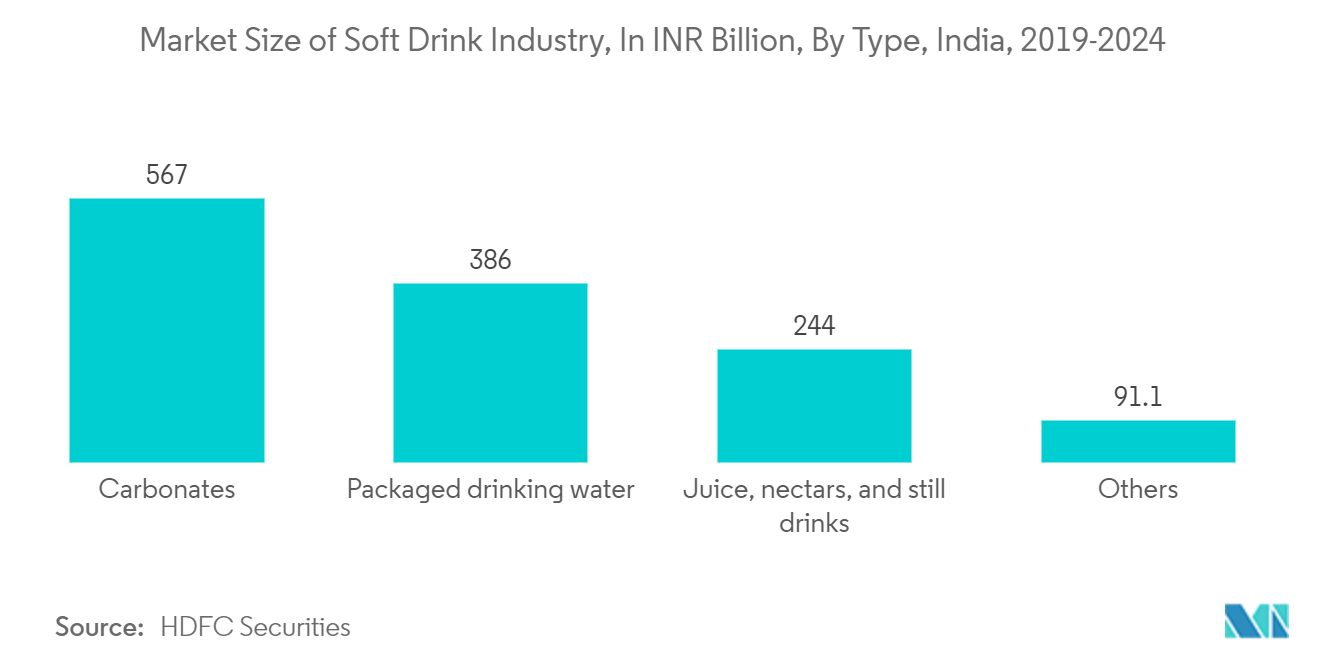
North America is Expected to Hold Significant Share
- The United States is anticipated to lead the North American FMCG packaging market due to its large population and substantial client base for the local industry. In North America, the United States is one of the main regions that is expanding as a result of increased transportation of goods, import and export activity, and governmental environmental safety regulations. People's changing preferences for biodegradable and sustainable packaging materials are also expected to influence market demand.
- Some of the major packaging businesses that are active in the industry are based in the nation. Some of them include Graphic Packaging International, WestRock, Packaging Corporation of America, Sonoco Production Company, International Paper Company, and Packaging Corporation of America.
- The expansion of FMCG packaging is also anticipated to be supported throughout the projection period by rising demand for fresh produce, bulk packaging, and storage and by activities related to international commerce. Progressive Grocers reports that fresh produce sales in the United States as a whole increased from USD 63.6 billion in 2019 to USD 75.8 billion as of May 2022.
- The e-commerce infrastructure in Canada is highly advanced and well connected to that in the US. Amazon, Wal-Mart, Canadian Tyre, Costco, Best Buy, Hudson's Bay, and Etsy are among of Canada's top online merchants.The ease of home delivery, retailers' omnichannel capabilities, and contextual consumer experiences are driving an increase in e-commerce expenditure in the United States. The U.S. Department of Commerce estimates that e-commerce sales reached USD 1.03 trillion in 2022, an increase of 7.44% over 2021 and 18.44% over 2020. 19.3% of all retail sales in the United States in 2022 were made through e-commerce.
- The Internet is the primary ordering channel for Canadian customers. In the last ten years, online consumer sales have increased more than traditional retail sales. To enhance business-to-business and business-to-consumer connections, the majority of Canadian retail businesses have embraced cellular technology and internet-based systems.
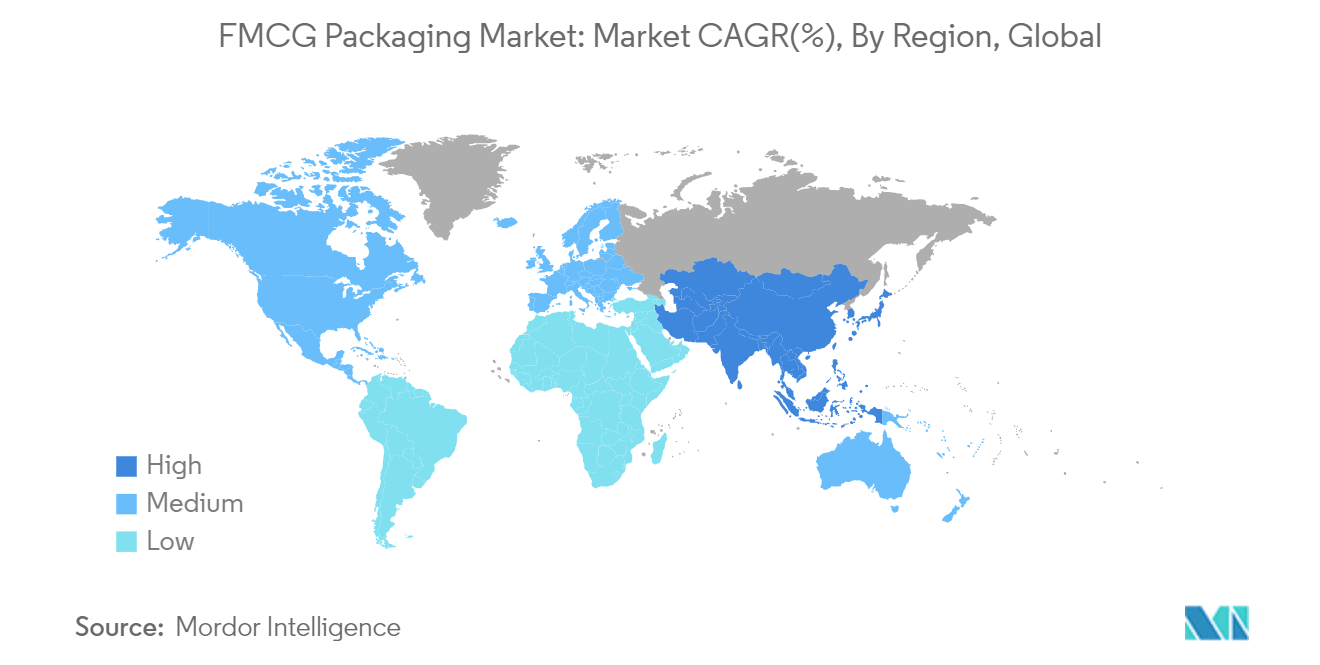
Fast-Moving Consumer Goods (FMCG) Packaging Industry Overview
The FMCG Packaging Market has the potential to shift rivalry, opening numerous new avenues for differentiation and value-added services. They will also enable firms to tailor offerings to more specific market segments and even customize products for individual customers, further enhancing differentiation and price realization. The firm concentration ratio is quite high because the concentration of unique brands and new players characterizes the market.
- February 2024 - The global packaging and paper group Mondi has acquired the Hinton Pulp mill in Alberta, Canada, from West Fraser Timber, a diversified wood products company. Completing this transaction, valued at USD 5m, follows the successful navigation of Canadian regulatory reviews and the fulfillment of standard closing conditions.
- October 2023 - Pakka Limited collaborated with Brawny Bear to launch India's first compostable flexible packaging to reduce the FMCG Industry's carbon footprint. The innovation will be launched in partnership with Brawny Bear, a nutrition company that uses the natural sweetness of dates to make delicious healthy food products. This represents a significant stride forward for India's packaging market, valued at over USD 70 billion.
Fast-Moving Consumer Goods (FMCG) Packaging Market Leaders
Amcor Limited
Ball Corporation
Berry Plastics Corporation
Tetra Pak International S.A.
DS Smith PLC
*Disclaimer: Major Players sorted in no particular order
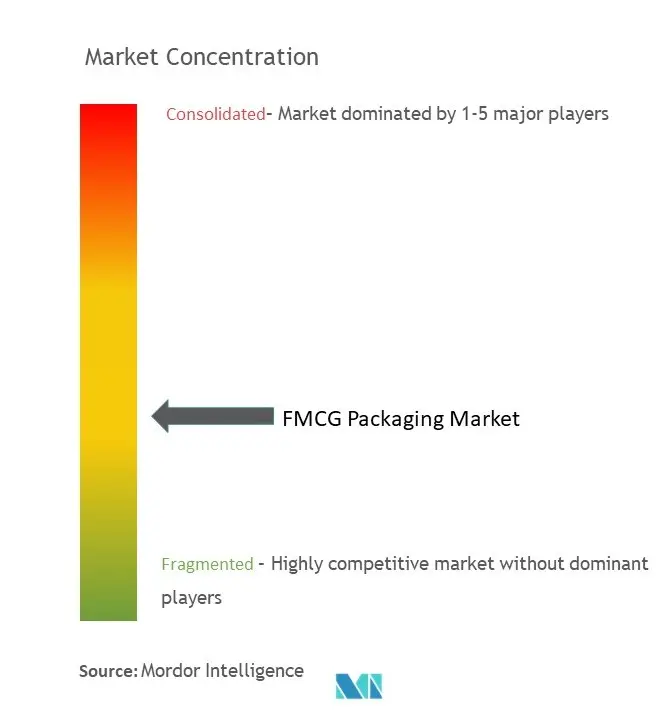
Fast-Moving Consumer Goods (FMCG) Packaging Market News
- February 2024 - Constantia Flexibles has agreed to acquire approximately 57% of the shares in packaging producer Aluflexpack. Aluflexpack, operating from 14 locations across Europe, specializes in foil and film packaging for the consumer and pharma markets.
- August 2023 - Major FMCG players are making virgin plastic reduction a key target, as 75% of consumers prefer environmentally friendly packaging. With plastics accounting for 3.4% of greenhouse gas emissions globally, cutting their use in packaging is essential to global carbon emission reduction efforts. To do this, major FMCG players, including Kraft Heinz, PepsiCo, and Coca-Cola, are making virgin plastic reduction a key target, alongside increasing the use of recycled plastics in the supply chain.
- April 2023 - Tetra Pak and The Walt Disney Company collaborate to bring Disney and MARVEL's enchantment to well-known milk drink categories. On the ambient white milk, fresh white milk, flavored milk, and protein drinks in beverage cartons under the Qualité & Prix brand from Coop in Switzerland, eighty Disney, and MARVEL-inspired graphics will be shown.
Fast-Moving Consumer Goods (FMCG) Packaging Market Report - Table of Contents
1. INTRODUCTION
1.1 Study Assumptions and Market Definition
1.2 Scope of the Study
2. RESEARCH METHODOLOGY
3. EXECUTIVE SUMMARY
4. MARKET DYNAMICS
4.1 Market Overview
4.2 Introduction to Market Drivers and Restraints
4.3 Market Drivers
4.3.1 Need Of Differentiated Packaging Products To Spur Demand
4.3.2 Increasing Demand For Small Sized And Convenient Packaged Products
4.4 Market Restraints
4.4.1 Stringent Government Regulations Regarding Environmental Safety
4.4.2 Lack Of Improvement In Technology To Hinder The Growth
4.5 Industry Value Chain Analysis
4.6 Industry Attractiveness - Porter's Five Forces Analysis
4.6.1 Bargaining Power of Suppliers
4.6.2 Bargaining Power of Consumers
4.6.3 Threat of New Entrants
4.6.4 Threat of Substitute Products
4.6.5 Intensity of Competitive Rivalry
4.7 Assessment of COVID-19 Impact on the FMCG Packaging Industry
5. MARKET SEGMENTATION
5.1 Material
5.1.1 Paper and Paperboard
5.1.2 Plastic
5.1.3 Metal
5.1.4 Glass
5.2 Application
5.2.1 Beverages
5.2.2 Food
5.2.3 Household and Personal Care
5.2.4 Other End-User Industries (Pet Care, Tobacco products)
5.3 Geography
5.3.1 North America
5.3.1.1 United States
5.3.1.2 Canada
5.3.2 Europe
5.3.2.1 United Kingdom
5.3.2.2 Germany
5.3.2.3 France
5.3.2.4 Spain
5.3.2.5 Rest of Europe
5.3.3 Asia-Pacific
5.3.3.1 China
5.3.3.2 India
5.3.3.3 Japan
5.3.3.4 South Korea
5.3.3.5 Rest of Asia-Pacific
5.3.4 Latin America
5.3.4.1 Brazil
5.3.4.2 Mexico
5.3.4.3 Rest of Latin America
5.3.5 Middle East and Africa
5.3.5.1 Gulf Cooperation Council (GCC)
5.3.5.2 Egypt
5.3.5.3 Nigeria
5.3.5.4 Kenya
5.3.5.5 South Africa
5.3.5.6 Turkey
5.3.5.7 Rest of Middle East & Africa
6. COMPETITIVE LANDSCAPE
6.1 Company Profiles
6.1.1 Amcor Ltd
6.1.2 Ball Corporation
6.1.3 Mondi Group
6.1.4 Sealed Air Corporation
6.1.5 DS Smith PLC
6.1.6 Consol Glass (Pty) Ltd.
6.1.7 Nampak Ltd.
6.1.8 Astrapak Ltd (RPC Group)
6.1.9 Mpact Pty Ltd.
6.1.10 Crown Holdings, Inc.
6.1.11 Stora Enso Oyj
6.1.12 Constantia Flexibles GmbH
6.1.13 Toyo Seikan Kaisha Limited
6.1.14 Berry Plastics Corporation
6.1.15 East African Packaging Industries Ltd (EAPI)
6.1.16 Albea SA
6.1.17 Tetra Pak International S.A.
6.1.18 Bonpak (Pty) Ltd.
6.1.19 Frigoglass South Africa (Pty) Ltd.
- *List Not Exhaustive
7. MARKET OPPORTUNITIES AND FUTURE TRENDS
Fast-Moving Consumer Goods (FMCG) Packaging Industry Segmentation
The design, manufacture, and distribution of packaging products and materials designed for fast-moving consumer goods constitute the FMCG (Fast-Moving Consumer Goods) packaging market. In the FMCG sector, packaging is extremely important since it keeps the goods safe during storage and transportation and allows for branding, customer convenience, and communication.
The FMCG packaging market is segmented by material type (paper and paperboard, plastic, metal, glass), application (beverage, food, household, and personal care), and Geography (North America [United States, Canada], Europe [United Kingdom, Germany, France, Spain, Rest of Europe], Asia-Pacific [China, India, Japan, South Korea, Rest of Asia-Pacific], (Latin America[Brazil, Mexico, Rest of Latin America], Middle East, and Africa [Gulf Cooperation Council (GCC), Egypt, Nigeria, Kenya, South Africa, Turkey, and Rest of Middle East & Africa]). The market sizes and forecasts regarding value (USD) for all the above segments are provided.
| Material | |
| Paper and Paperboard | |
| Plastic | |
| Metal | |
| Glass |
| Application | |
| Beverages | |
| Food | |
| Household and Personal Care | |
| Other End-User Industries (Pet Care, Tobacco products) |
| Geography | |||||||||
| |||||||||
| |||||||||
| |||||||||
| |||||||||
|
Fast-Moving Consumer Goods (FMCG) Packaging Market Research FAQs
How big is the FMCG Packaging Market?
The FMCG Packaging Market size is expected to reach USD 0.89 trillion in 2024 and grow at a CAGR of 4.60% to reach USD 1.12 trillion by 2029.
What is the current FMCG Packaging Market size?
In 2024, the FMCG Packaging Market size is expected to reach USD 0.89 trillion.
Who are the key players in FMCG Packaging Market?
Amcor Limited, Ball Corporation, Berry Plastics Corporation, Tetra Pak International S.A. and DS Smith PLC are the major companies operating in the FMCG Packaging Market.
Which is the fastest growing region in FMCG Packaging Market?
Asia Pacific is estimated to grow at the highest CAGR over the forecast period (2024-2029).
Which region has the biggest share in FMCG Packaging Market?
In 2024, the North America accounts for the largest market share in FMCG Packaging Market.
What years does this FMCG Packaging Market cover, and what was the market size in 2023?
In 2023, the FMCG Packaging Market size was estimated at USD 0.85 trillion. The report covers the FMCG Packaging Market historical market size for years: 2019, 2020, 2021, 2022 and 2023. The report also forecasts the FMCG Packaging Market size for years: 2024, 2025, 2026, 2027, 2028 and 2029.
FMCG Packaging Industry Report
Statistics for the 2024 FMCG Packaging market share, size and revenue growth rate, created by Mordor Intelligence™ Industry Reports. FMCG Packaging analysis includes a market forecast outlook to 2029 and historical overview. Get a sample of this industry analysis as a free report PDF download.
